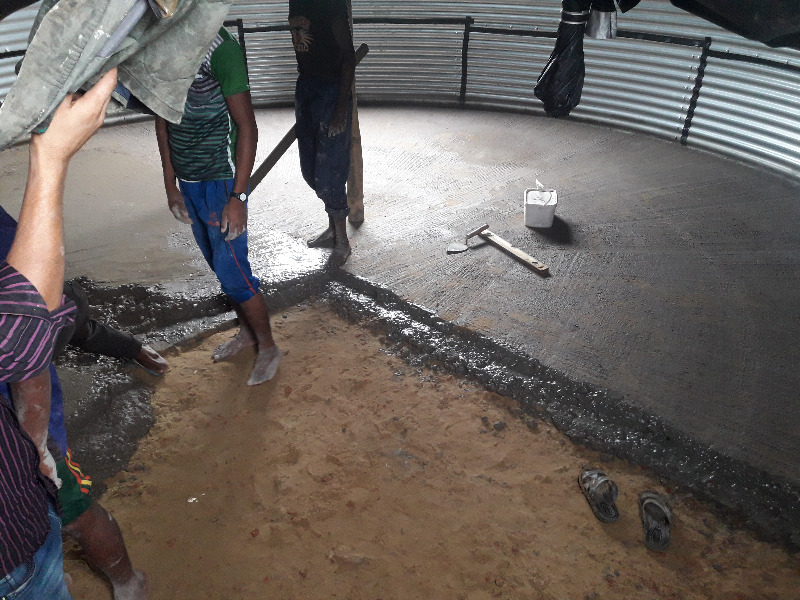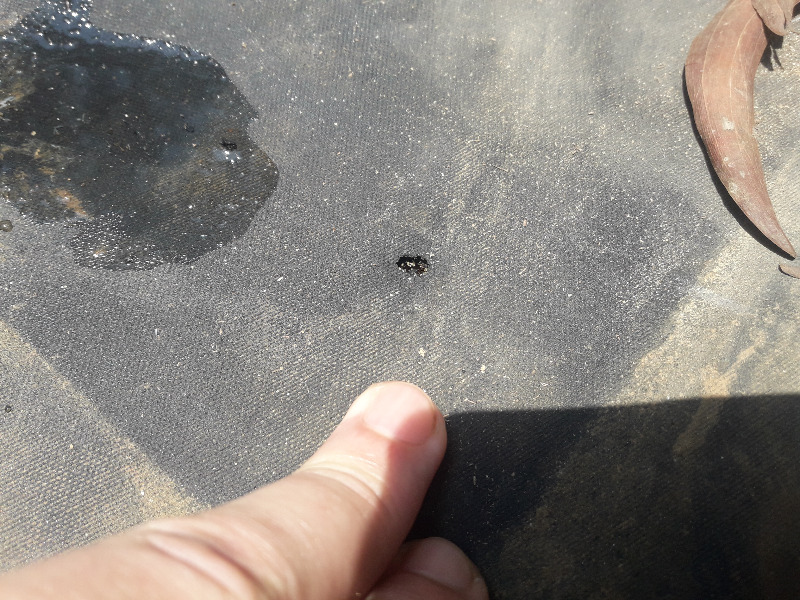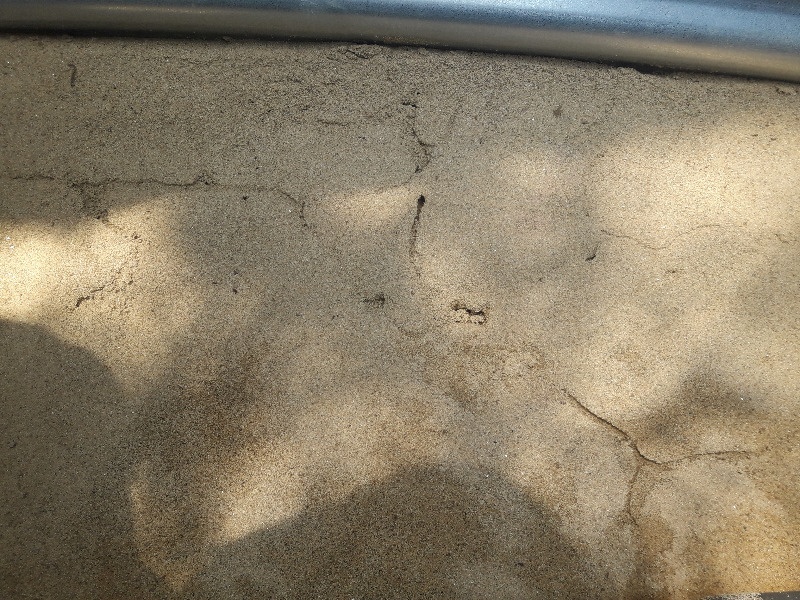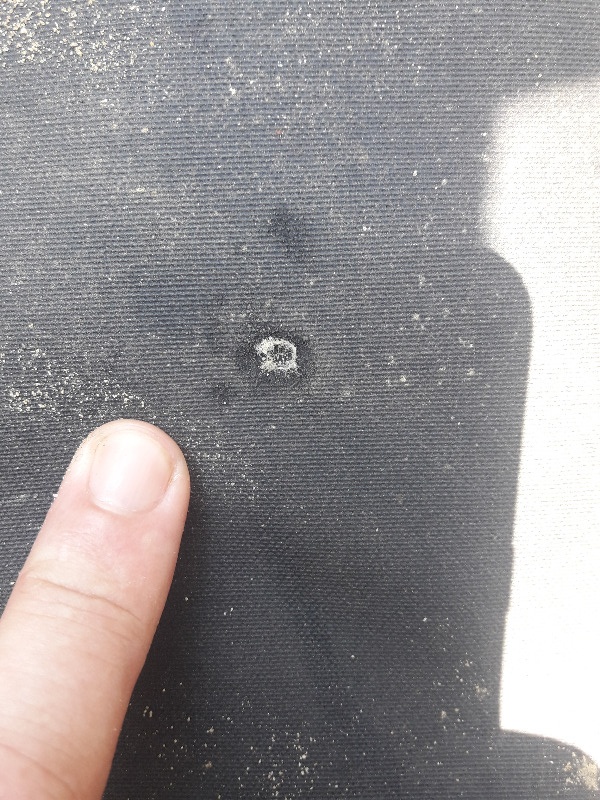- Forum
- categories
- Sanitation systems
- Water supply
- Oxfam Water Tank Liner damaged by Insects (termites/ants) - Cox's Bazar / Bangladesh
Oxfam Water Tank Liner damaged by Insects (termites/ants) - Cox's Bazar / Bangladesh
7015 views
- Andreas
-
 Topic AuthorLess
Topic AuthorLess- Posts: 5
- Likes received: 1
We opened the tank walls on two sides by removing one metal sheet. We lofted the liner instead removing steel roof and liner. We digged the sand layer out. We placed a 3 inch concrete slab on top of the platform. We covered the slab with a 3 inch sand layer. The sand was sieved to make sure no insects (termites/ants) are back-filled and the sand was treated with a 1% chlorine solution inside the tank. Liner down, metal sheets back. Only tricky remaining part is that the screws of the metal sheets should be holded manually from inside while closing the nuts from outside and the corners of the metal sheets need to covered by solid black tape to prevent liner damages...
Attachments:
-
 20190702_103323.jpg
(Filesize: 239KB)
20190702_103323.jpg
(Filesize: 239KB)
The following user(s) like this post: JKMakowka
Please Log in to join the conversation.
You need to login to replyRe: Oxfam Water Tank Liner damaged by Insects (termites) - Cox's Bazar / Bangladesh
Hmm, yeah those burrow lines in the sand look a lot like insects are at fault.
However I doubt you will be able to cast a crack free cement slab under these conditions, and can you really keep the tanks out of operation for that long?
I would try with these tarsheets used for roofs. They are pretty flexible and can be totally sealed. I also suspect that they are inedible for termites, but I have no actual experience with that.
It has been some months since I was last in Cox's Bazar... but somehow I recollect having seen such tarsheets there. But it might be difficult to procure.
However I doubt you will be able to cast a crack free cement slab under these conditions, and can you really keep the tanks out of operation for that long?
I would try with these tarsheets used for roofs. They are pretty flexible and can be totally sealed. I also suspect that they are inedible for termites, but I have no actual experience with that.
It has been some months since I was last in Cox's Bazar... but somehow I recollect having seen such tarsheets there. But it might be difficult to procure.
Please Log in to join the conversation.
You need to login to reply- Andreas
-
 Topic AuthorLess
Topic AuthorLess- Posts: 5
- Likes received: 1
Re: Oxfam Water Tank Liner damaged by Insects (termites) - Cox's Bazar / Bangladesh
Dear Kris,
we also had a very hard time to imagine that insects caused this damage.
But since we could exclude transport and storage damage as well as damage through installing staff, we discovered ants and termites. The holes were clearly bigger on the down side than on the top inside of the liner. Damage during installation can be excluded since all staff worked without shoes and all tools and used materials were wrapped with cloth to protect the liner. See three photos attached. So be believe that the 60 holes in the tank must be caused by the present insects living under the liner.
So our plan is now to emove steel or plastic roofs, remove the liner, dig the sand layer out, down to the platform, seal the platform with a 2 inch concrete slab, refill 4 inch of sieved or treated sand to protect the liner and reinstall liners and roofs.
Any further thoughts, advice or opinions on liner damaged by insects are most welcome.
Best,
Andreas*
we also had a very hard time to imagine that insects caused this damage.
But since we could exclude transport and storage damage as well as damage through installing staff, we discovered ants and termites. The holes were clearly bigger on the down side than on the top inside of the liner. Damage during installation can be excluded since all staff worked without shoes and all tools and used materials were wrapped with cloth to protect the liner. See three photos attached. So be believe that the 60 holes in the tank must be caused by the present insects living under the liner.
So our plan is now to emove steel or plastic roofs, remove the liner, dig the sand layer out, down to the platform, seal the platform with a 2 inch concrete slab, refill 4 inch of sieved or treated sand to protect the liner and reinstall liners and roofs.
Any further thoughts, advice or opinions on liner damaged by insects are most welcome.
Best,
Andreas*
Attachments:
-
 20190422_122750.jpg
(Filesize: 274KB)
20190422_122750.jpg
(Filesize: 274KB)
-
 20190422_122855.jpg
(Filesize: 307KB)
20190422_122855.jpg
(Filesize: 307KB)
-
 20190422_123127.jpg
(Filesize: 270KB)
20190422_123127.jpg
(Filesize: 270KB)
Please Log in to join the conversation.
You need to login to reply- Andreas
-
 Topic AuthorLess
Topic AuthorLess- Posts: 5
- Likes received: 1
Dear Ashok,
thank you very much for your effort and propositions. Unfortunately we are not in the position to replace the tank with ferrocement. Accordingly your propositions do not really address our challenge. Our challenge is to improve the existing situation. But we will definitely consider ferrocement tanks for future projects.
Thaks again.
Andreas*
thank you very much for your effort and propositions. Unfortunately we are not in the position to replace the tank with ferrocement. Accordingly your propositions do not really address our challenge. Our challenge is to improve the existing situation. But we will definitely consider ferrocement tanks for future projects.
Thaks again.
Andreas*
Please Log in to join the conversation.
You need to login to replyRe: Oxfam Water Tank Liner damaged by Insects (termites) - Cox's Bazar / Bangladesh
The IOM might help you with some borax or other chemical from their pilot bamboo treatment facility. But please be aware that it is easily washed out by water and a bit of an environmental hazard (similar to other fertilizer salts).
But I honestly have a bit of a hard time imagining that termites would be interested and able to bite through these thick rubber liners.
What other sources have you considered? My first guess would have been installation damage by workers walking inside with small pieces of brick-chips stuck to their shoes.
But I honestly have a bit of a hard time imagining that termites would be interested and able to bite through these thick rubber liners.
What other sources have you considered? My first guess would have been installation damage by workers walking inside with small pieces of brick-chips stuck to their shoes.
Please Log in to join the conversation.
You need to login to reply- Ashok
-
Less
- Posts: 42
- Karma: -1
- Likes received: 16
Re: Oxfam Water Tank Liner damaged by Insects (termites)
A major advantage of ferrocement water tanks is that it need not completely rest on the ground or pedestal.
A domical base can be provided and tank supported on four small pillars giving clear space between the tank and ground and thus ruling out the possibility of termite infection altogether.
A domical base can be provided and tank supported on four small pillars giving clear space between the tank and ground and thus ruling out the possibility of termite infection altogether.
Please Log in to join the conversation.
You need to login to reply- Andreas
-
 Topic AuthorLess
Topic AuthorLess- Posts: 5
- Likes received: 1
Thank you @Ashok for information and proposition with ferrocement tanks. This moght be a good idea to consider for any future tanks. It can unfortuantely not be applied for the constructed ones.
Any further opinions, advice, information and propositions are very welcome!
I received another answer in the "KnowledgePoint Forum" that I wanted to share with you:
There are several approaches to termite protection, none of which are mutually exclusive (so you can try all and any of them). The first is the barrier method, where you insulate your vulnerable structure with other structures that resist attack. The second is poisoning and the third is setting traps.
From what you describe, it seems that you may have already imported some infestation in the tank fill material, so it will only be possible to use barriers on future constructions. This might be difficult anyway because of the need to achieve an absolute seal between the fill and the tank liner. One approach might therefore be to sterilise the fill material before use it, e.g by roasting over a fire or by spreading out thinly in bright daylight (termites don't like daylight).
The simplest and cheapest non-persistent and non toxic termite poisons are vinegar and borax. The existing structures could be sprayed with these - probably several times before the tank is filled. The best trap is apparently wet cardboard. This is like caviar to termites, so a management strategy might be to leave pieces of wet cardboard in the vicinity of the tanks and regularly take them out and burn them before replacing with new. There is a range of of commercial termite trapping systems, many of which have to be set out around the area and buried in the ground ( a bit like slug traps).
Any further opinions, advice, information and propositions are very welcome!
I received another answer in the "KnowledgePoint Forum" that I wanted to share with you:
There are several approaches to termite protection, none of which are mutually exclusive (so you can try all and any of them). The first is the barrier method, where you insulate your vulnerable structure with other structures that resist attack. The second is poisoning and the third is setting traps.
From what you describe, it seems that you may have already imported some infestation in the tank fill material, so it will only be possible to use barriers on future constructions. This might be difficult anyway because of the need to achieve an absolute seal between the fill and the tank liner. One approach might therefore be to sterilise the fill material before use it, e.g by roasting over a fire or by spreading out thinly in bright daylight (termites don't like daylight).
The simplest and cheapest non-persistent and non toxic termite poisons are vinegar and borax. The existing structures could be sprayed with these - probably several times before the tank is filled. The best trap is apparently wet cardboard. This is like caviar to termites, so a management strategy might be to leave pieces of wet cardboard in the vicinity of the tanks and regularly take them out and burn them before replacing with new. There is a range of of commercial termite trapping systems, many of which have to be set out around the area and buried in the ground ( a bit like slug traps).
Please Log in to join the conversation.
You need to login to reply- Ashok
-
Less
- Posts: 42
- Karma: -1
- Likes received: 16
Re: Oxfam Water Tank Liner damaged by Insects (termites)
To the best of my knowledge, Termites have to reach open sun light once in 24 hours.
Therefore, what you do, they will come out, somewhere or other because it is a matter of survival for them.
For a termite infested area, the solution lies in not using rubber or plastic tanks but ferrocement tanks, which would cost about $70 per thousand litre (As per present Indian market).
Therefore, what you do, they will come out, somewhere or other because it is a matter of survival for them.
For a termite infested area, the solution lies in not using rubber or plastic tanks but ferrocement tanks, which would cost about $70 per thousand litre (As per present Indian market).
Please Log in to join the conversation.
You need to login to reply- Andreas
-
 Topic AuthorLess
Topic AuthorLess- Posts: 5
- Likes received: 1
Oxfam Water Tank Liner damaged by Insects (termites/ants) - Cox's Bazar / Bangladesh
Aloha*
We constructed several Oxfam water tanks, 70 m3 and 90m3, on 2m and 3m elevated platforms in the Cox's Bazar refugee camps. The platform consists of a round brick and concrete walls, back-filled with brick-chips and sand. On top of the tank platform we erected the water tanks. Inside, on top of the platform there is at 4 inch sand layer to protect the tank liner.
Now we discovered in two tanks between 30 and over 60 small holes in the tank liner, caused by probably termites or ants, only from the bottom into the tank, no holes were found in the walls of the liner. The termites must have been in the back-fill material and might eat holes into the liner to reach the comfortable stable and cool temperature of the tank.
How would you get rid of these insects? Concrete layer between liner and platform as a physical barrier? What about insecticides or other substances as a chemical measure to kill or to chase the termites? But insecticides might not be the greatest option regarding the proximity of drinking water?
Any advice or ideas are much appreciated!
Andreas*
We constructed several Oxfam water tanks, 70 m3 and 90m3, on 2m and 3m elevated platforms in the Cox's Bazar refugee camps. The platform consists of a round brick and concrete walls, back-filled with brick-chips and sand. On top of the tank platform we erected the water tanks. Inside, on top of the platform there is at 4 inch sand layer to protect the tank liner.
Now we discovered in two tanks between 30 and over 60 small holes in the tank liner, caused by probably termites or ants, only from the bottom into the tank, no holes were found in the walls of the liner. The termites must have been in the back-fill material and might eat holes into the liner to reach the comfortable stable and cool temperature of the tank.
How would you get rid of these insects? Concrete layer between liner and platform as a physical barrier? What about insecticides or other substances as a chemical measure to kill or to chase the termites? But insecticides might not be the greatest option regarding the proximity of drinking water?
Any advice or ideas are much appreciated!
Andreas*
Please Log in to join the conversation.
You need to login to reply
Share this thread:
- Forum
- categories
- Sanitation systems
- Water supply
- Oxfam Water Tank Liner damaged by Insects (termites/ants) - Cox's Bazar / Bangladesh
Recently active users. Who else has been active?
Time to create page: 0.176 seconds








